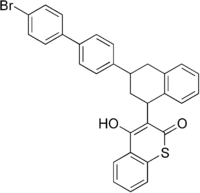Difethialone
From Wikipedia, the free encyclopedia
| Difethialone | ||
|---|---|---|
 | ||
| IUPAC name 3-[3-[4-(4-Bromophenyl)phenyl]-1-tetralinyl]-2-hydroxy-4-thiochromenone | ||
| Identifiers | ||
| CAS number | 104653-34-1 | |
| PubChem | 91771 | |
| KEGG | C18695 | |
| Jmol-3D images | Image 1 | |
| ||
| Properties | ||
| Molecular formula | C31H23BrO2S | |
| Molar mass | 539.48212 | |
| Except where noted otherwise, data are given for materials in their standard state (at 25 °C (77 °F), 100 kPa) | ||
| Infobox references | ||
Difethialone is an anticoagulant used as a rodenticide.[1]
It is considered a second generation agent.[2]
In May 2008 the United States Environmental Protection Agency banned the use of difethialone in consumer-use rodenticide products and also for exterior use by commercial applicators.[3]
References
- ↑ Nahas K, Lorgue G, Mazallon M (1989). "Difethialone (LM-2219): a new anticoagulant rodenticide for use against warfarin-resistant and -susceptible strains of Rattus norvegicus and Mus musculus". Ann. Rech. Vet. 20 (2): 159–64. PMID 2751229.
- ↑ Saravanan K, Kanakasabai R, Thiyagesan K (June 2003). "Field evaluation of difethialone, a new second generation anticoagulant rodenticide in the rice fields". Indian J. Exp. Biol. 41 (6): 655–8. PMID 15266918.
- ↑ http://www.epa.gov/pesticides/reregistration/rodenticides/finalriskdecision.htm
| |||||||||||||||||||||||||||||||||||||||
This article is issued from Wikipedia. The text is available under the Creative Commons Attribution/Share Alike; additional terms may apply for the media files.